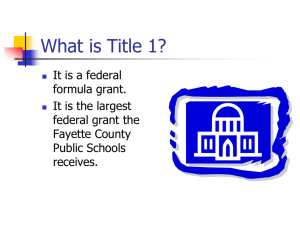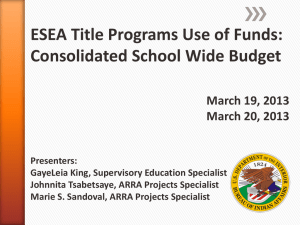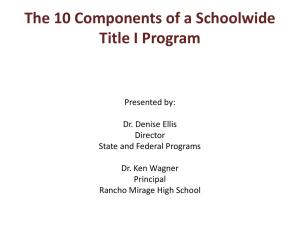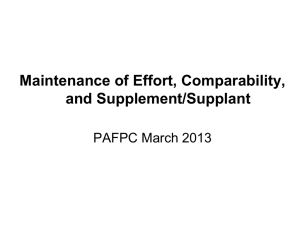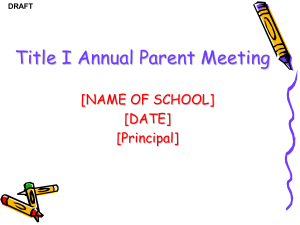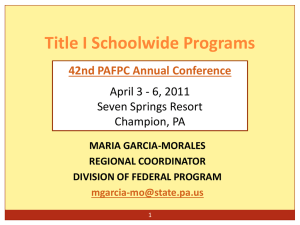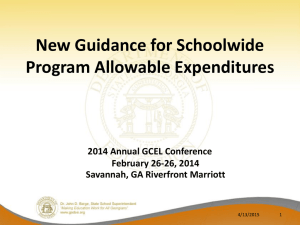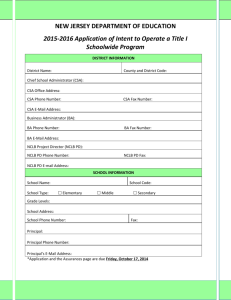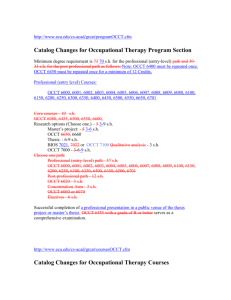DashboardPowerpoint
advertisement
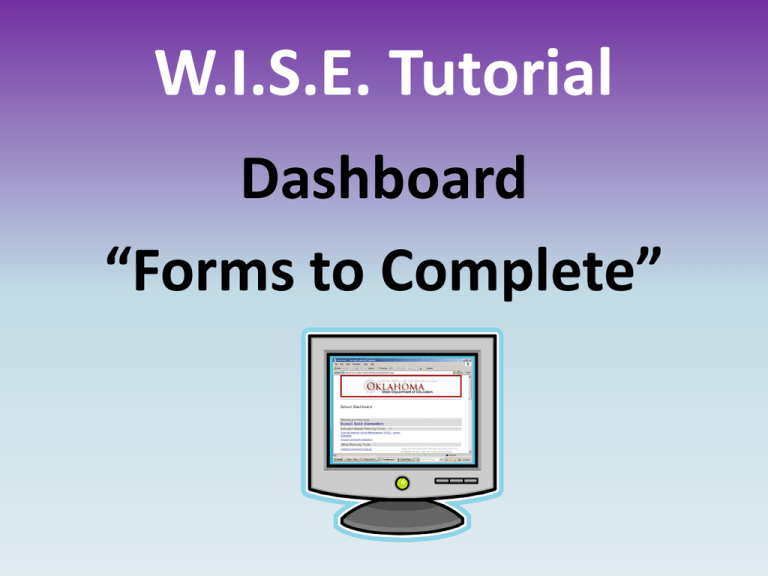
W.I.S.E. Tutorial Dashboard “Forms to Complete” This PowerPoint provides a step-by-step explanation of required form(s) on the WISE Dashboard. • All schools will complete the Schoolwide Program Supplemental Documentation form. • Schools in Improvement will also complete the School Improvement Supplemental Plan – Title I Schools form. WISE When you sign on, the first window you see is the “dashboard.” Scroll down to “Forms to Complete” and select Schoolwide Program Supplemental Documentation. Your answer boxes will be blank. Sample answers are available on the “ok/ok” training site (pictured) and on our TPS WISE site. Question no. 1 “adequate” Examples located answers (located on the “ok/ok” on “ok/o” training site and in document form on training site. the TPS WISE site…) Schoolwide Program Supplemental Documentation Example for Question no. 1 1. Based on state assessment data, what are the specific academic needs of students and which groups of students, if any, are not yet achieving the State's academic standards for proficiency and what are the SMART Goals the school has established to meet those needs? (Rubric Component S.1) • Not Adequate: The school's area of need is math. The goal for next year is to raise math scores. • Adequate: Based on the data including the Oklahoma Core Curriculum Test (OCCT)results, district benchmarks, and report card grades, the identified area of need is math for the Individualized Educational Plan (IEP) subgroup. While all other subgroups scored at or above the state benchmark, the IEP subgroup did not make AYP. The math score for the IEP subgroup was 940. To eliminate this gap, the school has set the following SMART Goals: • Math Scores for students in the IEP subgroup at Happy Hills Elementary will increase from 940 to the state benchmark of 1074 on the 2010-2011 OCCT. The number of 3-8th grade students scoring proficient or advanced on the 2010 math OCCT at Happy Hills Elementary will increase 15% per grade. A “Smart Goal” is: Keep referring to these guidelines as you compose your answer for no. 1 on the Schoolwide Program Supplemental Documentation. • Strategic and Specific - Strategic goals reflect the areas of highest need, the area where the gap between the school’s vision and current reality is the greatest. To be strategic means that a goal also aligns with other initiatives, such as those in the district. Specific goals identify with sufficient detail the who and what the school needs to target. Specificity allows schools to focus resources and attention for the greatest benefit. • Measurable - A measurable goal is one that defines the starting point and the final value to be achieved. By using measurable goals, school can adjust resources or reforms based on continuous evaluation and feedback. • Attainable - Attainable goals are those that have a final value, a measure, that is reachable within the given time frame. Attainable goals, however, are not goals that are aimed low, but rather are goals that stretch the previous achievement level. • Results Based - Results-based goals are those that have built in benchmarks or progress monitoring checks to measure efforts. Assessments, evaluation tools and responsible parties are all assigned before efforts begin. • Time Bound - A time bound goal is one that has a specific time frame. This is critical as it builds internal accountability and motivates those involved to take action. More Examples of SMART Goals: • The percentage of all students in grades 3-5 at Anytown Elementary who score satisfactory or above in reading on the Oklahoma Core Curriculum Test (OCCT) will increase from the current 67% to 75% in the 2011-2012 school year. • The API mathematics score for students in the IEP subgroup will increase from 894 to the identified state performance benchmark of 1074 in the 2011-2012 school year. Is the entire goal attainable and truly results based? Refer to your guidelines on previous slide or your WISE Tool book (p. 86.) Strategic and Specific Measurable Attainable Results Based Time Bound Question no. 1 “adequate” answers (located on the “ok/ok” training site and in document form on the TPS WISE site…) Schoolwide Program Supplemental Documentation Example Answer no. 2 2. Describe how the school will annually evaluate the implementation of, and results achieved by, the schoolwide program, determine whether the schoolwide program has been effective in increasing the achievement of students in meeting the State's academic standards, and revise the plan, as necessary, to ensure continuous improvement of students in the schoolwide program. Rubric Component S.2) Not Adequate: The schoolwide plan will be annually reviewed by the Title I Director. The Title I Director will make revisions as needed. Adequate: The school has established a Title I planning committee. The Title I planning committee includes members of all stakeholder groups. The committee meets twice a year to monitor the progress of the plan. At the spring meeting, the committee determines whether 1) the plan was implemented as written and 2) whether the SMART goals were met. A written report is provided to all staff and parents at the May PTO meeting. After review of the report, the Title I planning committee revises the schoolwide plan, as necessary. Revision may include setting new SMART goals, revising action steps to achieve goals not met, or revising information related to the 10 required components. Because the school will be using the WISE Planning Tool for the first time in the 2010-2011 school year, the review process will change. The Title I planning committee will meet on a monthly basis to check the status of the assigned tasks and action plans. The will prepare a report for the monthly PTO meetings. All action plans will be revised, as necessary, to ensure full implementation of the indicators. Each year, a comprehensive annual review will be conducted and the results will inform the assessment and action plans for the next school year. Question no. 1 “adequate” answers (located on the “ok/ok” training site and in document form on the TPS WISE site…) Schoolwide Program Supplemental Documentation Answer Example no. 3 3. The law requires that the Schoolwide Program plan shall be developed with the involvement of (a) parents and other members of the community to be served and (b) individuals who will carry out the plan (i.e., teachers, principals, administrators of other federal programs and any other individuals whose work will be impacted by schoolwide plan.) (Rubric Component S.3) Please describe how the school has met the intent of this section of the law. Not Adequate: The schoolwide plan is developed by the Title I planning committee. The committee includes the principal, the Title I Director, a Title I teacher, the school counselor, and the media specialist. The completed plan is then presented to a group of parents and they are allowed to give feedback on the plan. Adequate: The schoolwide planning committee consists of the principal, the Title I Director, three faculty members, the school counselor, the school-based social worker, and a parent from each grade level. This committee develops the schoolwide plan through a series of meetings and a comprehensive needs assessment. All members meet once a month to discuss the schoolwide plan and provide feedback. When the plan is completed, it is presented to the staff in the annual Title I meeting and to all parents in multiple Title I parent meetings. The parents are surveyed on Title I annually and these surveys are used by the planning team to make revisions for the next school year. This Rubric for the Dashboard component is part of the Rubric which will be used by the district and The district and statestate towill assess your entire plan. It may be found use these rubrics t assess your B of your WISE Tool book. in Appendix plan! These rubrics can be found in Appendix B of your WISE Tool book. This is completed only by schools in need of improvement. This is completed only by schools in need of improvement. Suggested language and talking points for the School Improvement Supplemental Plan form are available on the TPS WISE site. Look for the following ‘helps’ documents on the TPS WISE site: * Examples of “Adequate and Inadequate Answers” for the Schoolwide Program Supplemental Documentation form * Suggested language and talking points for the School Improvement Supplemental Plan – Title I Schools form * SMART Goals Guidelines and Examples Directions to TPS WISE Site: TPS Website • Departments • Professional Development • WISE tab • School Improvement Supplemental Documentation helps document. • Cadre 1 – November 5th Academy Central (MD) Alcott (MD) Houston (MD) Key (MD) Lindbergh (JS) MacArthur (JS) McClure (MD) McKinley (JS) Roosevelt (MD) Sequoyah (JS) Whitman (MD) Cleveland (ES) Clinton (ES) Tulsa Met-Franklin (PV) Gilcrease (ES) Lewis and Clark (PV) Madison (PV) Whitney (PV) Byrd (PV) Central (ES) Rogers (ES) Hale (ES) Nimitz (PV) Kendall-Whittier (MD) Cadre 2 – January 15th Anderson (MD) Celia Clinton (JS) Cherokee (MD) Disney (JS) Emerson (MD) Hawthorne (MD) Jackson (JS) Jones (JS) Kerr (JS) Peary (JS) Phillips (MD) Remington (JS) Eugene Field (JS) Owen (JS) Park (JS) Patrick Henry (MD) Barnard (MD) Bell (JS) Bryant (JS) Columbus (JS) Marshall (MD) Sandburg (JS) Springdale (JS) KIPP (PV) Edison MS (ES) Foster (PV) Hamilton (PV) Wilson (PV) Memorial (ES) McLain (PV) Tulsa Met-Lombard (ES) East Central (ES) Cadre 3 – January 15th Addams (JS) ECDC Reed and Bunche (MD) Burroughs (MD) Carnegie (MD) Chouteau (MD) Cooper (JS) Eisenhower (JS) Eliot (MD) Greeley (MD) Grimes (MD) Grissom (MD) Hoover (JS) Lanier (JS) Lee (MD) Mark Twain (MD) Mayo (JS) Mitchell (JS) Penn (MD) Robertson (JS) Salk (MD) Skelly (JS) Wright (JS) Zarrow (JS) Thoreau (ES) Carver (PV) Edison HS (ES) BTW (ES) Webster (ES) TRAICE (PV) WISE Coaches: Maribeth Dean * Eileen Simmons * Jan Smith * Pamela Vickers For assistance, contact your WISE coach • Maribeth Dean 925-1114 – deanma3@tulsaschools.org • Eileen Simmons 925-1147 – simmoei@tulsaschools.org • Jan Smith 925-1117 – smithja2@tulsaschools.org • Pamela Vickers 925-1190 – vickepa@tulsaschools.org
